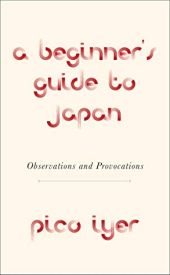A Beginner’s Guide to Japan

Observations and Provocations
by Pico Iyer
Completed: April 14, 2021- Other
- 240 pages
- ISBN: 9780451493958
- Goodreads page
“If you think, ‘I breathe,’” said Shunryu Suzuki, the Zen teacher, “the ‘I’ is extra.”
“Emotions,” writes the Zen philosopher D. T. Suzuki, “are just the play of light and shadow on the surface of the sea.”
Was divided between 1 and 2 stars, but that there are at least a few quotable parts tended to increase my view of this book. It’s passable at best, unfortunately. Not quite my cup of tea.
“My colleague spends two hours a day making herself up,” my wife says, on her way to the department store where she works.
“She wants everyone to look at her?”
“No. She wants everyone not to.”
Japan has a sharp-edged sense of what can be perfected – gizmos, surfaces, manners – and of what cannot (morals, emotions, families). Thus it’s more nearly perfect on the surface than any country I’ve met, in part because it’s less afflicted by the sense that feelings, relationships or people can ever be made perfect.
The ratio of engineers to lawyers in Japan – of people building things as opposed to people organizing arguments – was forty-one times greater than in the United States for years after I arrived in Japan.
A couple of parts were definitely fascinating:
The earliest historical texts in Japan, dating from 712 and 720 respectively, take whole incidents and speeches from Chinese history and present them as Japanese.
But other good parts were better described by Patrick McKenzie in his blog post Doing Business in Japan. For example:
In terms of wealth distribution, Japan in 2017 was “the most equal” society on the planet; many CEOs in Japan earn less than some of their employees do. But in terms of the gulf in public status, Japan is much more unequal than the United States. There’s no overturning the hierarchy.
Or
“I traveled around Japan these last three years,” says my friend the techno-visionary Kevin Kelly, “and I never saw a single broken roof tile. Not one. On the other hand, I didn’t see much new construction. Maintenance: that’s what Japan does.”
And indeed, one should expand this to say, “Maintenance: that’s precisely what India does not do.”
Some of the best parts of the book are discussing the US much more so than Japan. While Japan is used as the contrasting lens, what applies here about Japan isn’t as unique as the author sometimes makes it out to be; rather, it is the American style that is unique instead, while the Japanese philosophy might be shared by, say, France.
This doesn’t mean that people in Japan are less individual than elsewhere. Their tastes and passions are as wildly divergent, as unpredictable, as their looks and voices may not be. When I return to California, I sometimes feel I’m stepping into a world in which everyone longs to be distinct – “themselves” – and yet many political positions and interests and inclinations can seem all but interchangeable.
Or
“Having to be different,” noted the artist Robert Rauschenberg, famous for his enigmatic all-white canvases, “is the same trap as having to be the same.”
Even modest restaurants in Japan often present you with a prix fixe menu. Freedom doesn’t mean an abundance of choice so much as liberation from the burden of too much choice.
And this definitely applies to India!
If you constant adapt to circumstances, however, will you ever be able to change them?
I did love this Dalai Lama anecdote:
“What do you do,” I saw a Canadian in a large auditorium in Japan ask the Dalai Lama, after a talk, “if you really love a foreign culture and you really want to be a part of it and you dream of being there for life, but everyone reminds you that you’re different?” The leader of the Tibetans looked at the young man with a grandfather’s warmth and said, “Frankly, I think you should go back to Canada.”
All book cover images are from Goodreads unless specified otherwise.